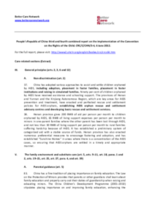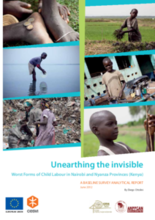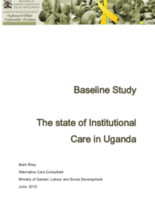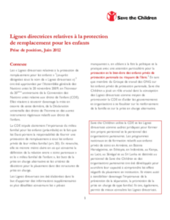Demographic Data:
|
Sources: World Bank, UNDP, DHS 2010-11 |
Displaying 12761 - 12770 of 14348
Desk review of existing literature and research to track the extent to which the HIV pandemic has been a driver of growth in children’s residential care and the situation of HIV affected children in care.
This video showcases the Family-based care program of Save the Children and its partners in Indonesia.
The People’s Republic of China issued its third and fourth combined report on the implementation of the Convention on the Rights of the Child in June 2012. This extract of the report focuses on sections relevant to children's care and in particular those addressing Family Environment and Alternative Care
This evaluation study was conducted in an effort to learn more about the innovative parent organizing model implemented by the Child Welfare Organizing Project (CWOP) in East Harlem, New York City and identify the role and impact of CWOP community representatives on birthparents, families, and child safety conference outcomes.
This discussion paper puts forward a set of lessons learned and recommendations for referral mechanisms and case management for vulnerable children in the Eastern and Southern Africa region (ESAR).
This study from CESVI examines the magnitude and characteristics of child labor in Kenya, particularly the “worst forms of child labour (WFCL) in Kenya,” with a focus on the urban context of Nairobi and on the rural context of the Nyanza province.
La présente étude réunit un grand nombre d’exemples de bonnes politiques et bonnes pratiques présentés lors de la journée de discussion générale du Comité des droits de l’enfant 2011 (DGD) sur le thème « Enfants de détenus ».
This document summarises the key findings of the project to-date and the current status of the child care and alternative care directory. It also outlines some key activities that need to be undertaken for the MoGLSD to start to address the issues outlined within the report. The MoGLSD has carefully evaluated the baseline study and after a number of consultations wish to put forward this document as a proposal to address the serious issues of children without parental care and the growing number of children’s homes.
Cette note d'orientation de Save the Children présente le contexte, les objectifs et les principes directeurs énoncés dans les lignes directrices pour la protection de remplacement des enfants. Elle explique également pourquoi la prise en charge familiale est le mode de protection de remplacement à preferer aux placement en institutions.
This International Labour Organization (ILO) document introduces a new international standard adopted in June 2012, the Social Protection Floors Recommendation, 2012 (No. 202), that provides guidance to member States in building comprehensive social security systems and extending social security coverage by prioritizing the establishment of national floors of social protection accessible to all in need.









